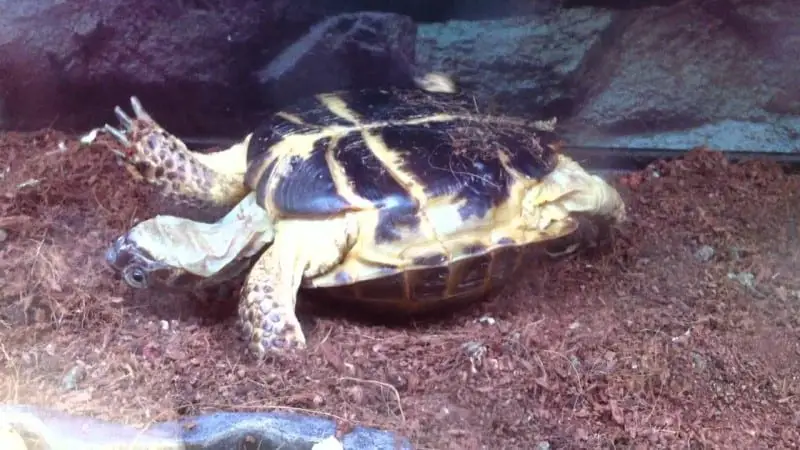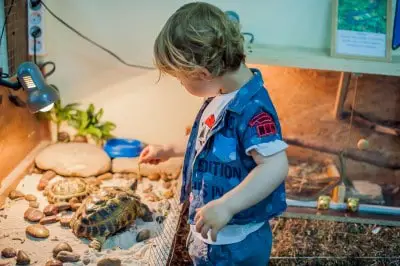Turtles are one of the most long-living pets. However, they eventually die due to natural causes or illnesses; therefore, it is best to prepare for the inevitable as a pet owner. If your pet is aging or suffering from a critical illness, you would want to know how to help them live through the remaining days.
The most important thing your pet needs when it’s dying is your care. Therefore, provide food, water, heat, lighting, and your undivided attention. You can stroke its shell and neck while establishing contact as you keep them company.
This article helps you deal with your pet’s loss and how to make them comfortable through the process. We will also educate you on the signs to look out for and the next step to take after your turtle’s death. Read on for these and more details.

Is Your Turtle Dying or Brumating?
Changes in seasonal and environmental conditions can adversely affect your pet turtle’s health. In most cases, it isn’t easy to distinguish a hibernating pet from an active one, especially as a first-time keeper. We aim to help you tell when your buddy is dying or is undergoing brumation.
A dying turtle is likely to have appetite loss and may reject food. At this stage, your pet may be suffering from a serious disease or has underlying life-threatening health conditions. On the contrary, a hibernating pet wouldn’t eat at all and can stay in the same spot for days. Here, the reptile is fine but stays inactive due to a drop in temperatures. When winter passes, your turtle will gradually wake up and return to its normal life routine, but the case is different for an ill turtle since it’s a matter of life and death.
A dying turtle’s health will deteriorate due to diseases and malnutrition since most of them lose their appetite around that time. On the other hand, your pet will be very healthy before brumating because they store fats to use all through the period. During this season, your shelled buddy will be utilizing stored energy because their metabolism significantly reduces. You can leave the turtle to hibernate until the end of winter, then wake it by dipping in warm water or raising the temperature in the room. However, for a dying turtle, the best you can do is keep it comfortable and ask a vet for the way forward.
Signs Your Turtle Is Dying
As a pet parent it is vital to understand your turtle’s body language to understand their health status; this includes how your pet looks when ill or when slipping into hibernation. Exotic pets like turtles are hardy creatures, and they may be sick for a long time without you noticing, and, in some cases, it may be too late. Experts advise staying a step ahead in matters of your turtle’s well-being and have a vet on standby in case of anything.
Turtles are adept at swimming, and you will find them splashing water frequently as they cruise in their enclosure. However, if you notice any sluggishness or general inactivity, it could be a red flag that something is up, and, if it persists, it could warrant a trip to the vet. Also, if your shelled friend rejects meals, loses weight, and you are certain that it’s not due to hibernating, you may conclude that he is seriously sick, possibly from digestive tract infections. Next, you should be on the lookout for signs of lethargy, such as sluggish movements and unusually slow responses to stimuli.
You can also check for symptoms such as running nose bubbles or watery eyes, which may indicate that your turtle is slowly dying. You may also see some swelling and irritations on various body parts. At this point, the only option is to contact an animal clinician urgently, or else, you may lose your pet. Besides, other sick turtles start sneezing, gasping, and frequently opening their mouths, which are the major signs of advanced respiratory illnesses.
In addition, skin ailments and excretion will tell you how seriously ill the turtle is. The symptoms prevail as a cracked shell, skin tumors, eye infections, or bloody droppings. If you notice any of these symptoms, it is best to seek immediate medical help because you may help save your pet’s life in the nick of time.
Read more: 9 Signs Your Tortoise Is Dying
How To Comfort a Dying Turtle
Your pets may die from old age, a life-threatening disease, or a critical injury, and you have to brace yourself for the worst. In such a case, you would want to stay with them through the whole process, but it may be too painful for them or you. Let’s find out how best you can handle the situation.
First, you need to consult with a vet to find out whether your pet will be fine. Some owners panic when they see their pets inactive, not knowing that they are undergoing hibernation. If your vet is a long drive away, you can try to keep your pet as comfortable as possible as you call in the medics. Sick turtles may end up drowning in the water; therefore, you need to relocate it to a safer and more conducive tank. Provide heat, lighting, clean but shallow water for hydration, and some blankets to keep warm if it opts to stay on the dry surface. It is advisable to remedy the current situation as you wait for a vet’s assistance.
Turtles and tortoises are generally inactive creatures, making it difficult to determine whether they are okay or not. Many will often rush them to the clinic worried sick that something is wrong while they are just relaxing or undergoing hibernation. You only need to be concerned when you notice particular signs that we discussed in the previous segments. If you don’t see anything abnormal, there’s no reason to panic. A healthy turtle has its skin intact, shows no secretions from their mouth and nose, and is excreting normally. Therefore, you can observe them for a while to look for any developments, and, if any, you can immediately consult a vet.
On the flip side, your turtle can be seriously ill or injured such that there’s nothing the vets can do, meaning that you have to prepare to lose your buddy. At this stage, you can provide more company, petting, and their favorite food items. Spending time together and stroking their shell is the care they need in their last days. You can also provide a different tank to prevent drowning and provide food, water, lighting, and heating. Perhaps, tender love will go a long way to improve their life’s quality and perhaps increase their lifespan.
What’s Next After Your Turtle’s Death?
Turtle pets are adorable, and it is easy to get attached to them. Therefore, it is understandable that their death will be a big blow to their owners. Although they have a long lifespan, they eventually die like any other animal. So, what next after your turtle’s death?
You can take the remains to a veterinarian, bury them in your backyard, contact animal authorities, or give the remains to an animal craftsman (taxidermist). Additionally, you can let the carcass decay at home without interfering with the shell if you need to retain it. Note that you should move quickly before the carcass starts rotting. It is advisable to safely discard the animal’s corpse within two or three days. Other owners opt to discard their animals’ remains in a dustbin. Not only is this inhumane, but also illegal in some countries, leading to arrests and fines.
The first issue that crosses your mind is how you will dispose of the corpse, especially if the pet died at home. Therefore, it is essential to know the national laws regarding pet disposal and burial. Some countries don’t allow you to bury animals or even human corpses in your backyard. In contrast, countries with eased rules don’t have issues with you burying your pet or making them a memorable cemetery in your garden.
There are other convenient ways to deal with your turtle’s carcass other than burying. Firstly, you can take the remains to an animal agency which would save you the hassle of disposing of it yourself. Secondly, you can ask animal vet clinics or taxidermists to assist. Clinicians can cremate the remains and handle them over to you to keep the ashes as memories. Similarly, they can remove all the flesh and hand over the shell if you need it. Finally, you can find a few taxidermists in your location that may need the remains for their artwork.
Finally
Humans forge strong bonds with their pets, and their loss hits them hard. If you receive the sad news that your pet is dying, it is best to spend more time together during the little time left. They need food, water, and any other essential requirements to keep them comfortable. You also need to think of the next step, either cremation, burial, or asking for professional help. However, if you are uncertain about your pet’s health status, you can consult your vet and learn how to tell when they are brumating to prevent false alarms.







